Abstract
Frequent sampling during an annual cycle of dissolved(<0.45 μm) and suspended (>0.45 μm) elementshas been conducted in the Kafue River at Raglan'sFarm, upstream from the mining activities within theCopperbelt Province, Zambia. Additional sampling ofsediment and interstitial pore water was conductedduring low water discharge. The presence of carbonateswithin the drainage basin naturally gives rise to highelement concentrations in the dissolved phase(Ca = 626, Mg = 494, Na = 360 and K = 24 mmol l-1).During the rainy season the relative composition ofthe dissolved elements indicated a wash out ofaccumulated weathering products and mineralisedorganic material from the unsaturated zone of the soilprofile. High concentrations of dissolved Al, Fe andMn were measured during high water discharge. At lowwater discharge the sediment was a major source of Fe,Mn and associated Co and Cu to the water column.Enhanced concentrations of dissolved and suspended S,Co and Cu during the rainy season indicated thatatmospheric deposited particles from the mining areawere washed out into the river. Autochthonousformation of particles rich in Si indicated diatomproduction during low water discharge.
Similar content being viewed by others
References
Allégre C. J., Dupré B., Négrel P. and Gaillardet J. (1996) Sr-Nd-Pb isotope systematics in Amazon and Congo River systems: Constraints about erosion processes, Chemical Geology 131, 93–112.
Andersson P. S., Wasserburg G. J. and Ingri, J. (1992) The source and transport of Sr and Nd isotopes in the Baltic Sea, Earth and Planetary Science Letters 113, 459–472.
Ball J. W. and Nordstrom D. K. (1991) Users manual for WATEQ4F with revised thermody namic data base and test cases for calculating speciation of major, trace, and redox elements in natural waters, US Geological Survey, Report 91–183.
Benedetti M. F., Menard O., Noack Y., Carvalho A. and Nahon D. (1994) Water-rock interactions in tropical catchments: field rates of weathering and biomass impact. Chemical Geology 118, 203–220.
Berner E. K. and Berner R. A. (1987) The global water cycle, geochemistry and environment, Prentice-Hall, Inc., pp. 174–240.
Bishop K. H., Grip H. and O'Neill A. (1990) The origins of acid runoff in a hillslope duringstorm events. Journal of Hydrology 116, 35–61.
Blomqvist S. (1985) Reliability of core sampling of soft bottom sediment-an in situ study, Sedimentology 32, 605–612.
Brass G. W. (1976) The variation in the marine 87Sr/86Sr ratio during phanerozoic time: Interpretation using a flux model, Geochim.Cosmochim.Acta. 40, 721–730.
Chapman P. J., Reynolds B. and Wheater H. S. (1993) Hydrochemical changes along stormflow pathways in a small moorland headwater catchment in Mid-Wales, UK, Journal of Hydrology 151, 241–265.
Chileshe L. (1988) The soils of the Copperbelt province memoir accompanying the 1: 1000000 soil map, Soil survey unit research branch, Department of Agriculture, Ministry of Agriculture and co-operatives, Republic of Zambia, Soil survey report No. 153, 57 pp.
Drever J. I. (1997) The geochemistry of natural waters, Prentice Hall, cop. 436 pp.
Elsenbeer H., West A. and Bonell M. (1994) Hydrologic pathways and stormflow hydrochemistry at South Creek, northeast Queensland, Journal of Hydrology 162, 1–21.
Eyrolle F., Benedetti M. F., Benaim J. Y. and Février D. (1996) The distribution of colloidal and dissolved organic carbon, major elements and trace elements in small tropical catchments, Geocim.Cosmochim.Acta 60(19), 3643–3656.
FAO/UNESCO. (1974) Soil map of the world, Vol. 1, Legend. UNESCO, Paris.
Faure G. (1986) Principles of isotope geology, 2nd ed. John Wiley & Sons Inc.
Hall A., Valente I. M. C. B. S. and Davies B. R. (1977) The Zambezi River in Moçambique: The physico-chemical status of the middle and lower Zambezi prior to the closure of the Cabora Bassa Dam, Freshwater Biology 7, 187–206.
Hay W.W. and Southam J. R. (1977) Modulation of marine sedimentation by the continental shelves, In: The fate of fossil fuel CO 2 in the oceans (eds. N. R. Andersen and A. Malahoff), Plenum Press, New York, pp. 569–604.
Ingri J., Torssander P., Andersson P. S. and Morth C M. (1994) Hydrogeochemistry of sulphurisotopes in the Kalix River catchment, northern Sweden, Mineralogical Magazine.58A(A-K), 442–443.
Ingri J. and Widerlund A. (1994) Uptake of alkali and alkaline-earth elements on suspended iron and manganese in the Kalix River, northern Sweden, Geochim Cosmochim Acta 24, 5433–5442.
JICA (Japan International Cooperation Agency). (1995) The study on the national water resources master plan in the republic of Zambia. Republic of Zambia Ministry of Energy and Water Development. Japan International Co-operation Agency, YEC.
Kennedy V. C., Zellweger G.W. and Jones B. F. (1974) Filter pore-size effects on the analysis of Al, Fe, Mn and Ti in water, Water Resources Res. 10, 785–790.
Land M. (1998) Weathering of till in northern Sweden and its implications for the geochemistry of soil water, groundwater and stream water, Luleå University of Technology, Doctoral thesis 1998:35. ISSN 1202–1544.
Land M., Ingri J., Andersson P. S. and Öhlander B. (1999) Ba/Sr and Ca/Sr ratios in soil water and groundwater: implications for relative contributions to stream water discharge, Applied Geochemistry 15(3), 311–325.
Lewin J. C. (1961) The dissolution of silica from diatoms walls, Geocim.Cosmochim.Acta 21, 182–198.
Li Y. and Gregory S. (1974) Diffusion of ions in sea water and in deep-sea sediments, Geochim.Cosmochim.Acta. 38, 703–714.
Likens G. E. and Bormann F. H. (1995) Biogechemistry of a forested ecosystem, Springer-Verlag, New York, pp. 80–94.
Martin J. M. and Whitfield M. (1983) The significance of the river input of chemical elements to the ocean, In: Trace metals in seawater (ed. C. S. Wong), Plenum Press, pp. 265–269.
Mason B. and Moore C. B. (1982) Principles of geochemistry, 4th ed., John Wiley & Sons, New York.
Mendelsohn F. (1961) The geology of the Northern Rhodesian Copperbelt, London, Macdonald & Co., pp. 17–80.
Meybeck M., Friedrich G., Thomas R. and Chapman D. (1992) Rivers. in: Water Quality Assessments A guide to the use of biota, sediments and water in environmental monitoring, (ed. D. Chapman), UNESCO/WHO/UNEP, Chapman and Hall, Cambridge, pp. 239–316.
Milliman J. D. (1980) Transfer of river-borne particulate material to the oceans, In: River inputs to ocean systems (eds. J.M. Martin, J. D. Burton, and D. Eisma), SCOR/UNEP/UNESCO,Review and Workshop, FAO, Rome, pp. 5–12.
Morel F. M. M. and Hudson R. J. M. (1985) The geobiological cycle of trace elements in aquatic systems: Redfield revisited, In: Chemical Processes in Lakes (ed. Stumm, W.), Wiley, pp. 251–281.
Mulder J., Pijpers M. and Christophersen N. (1991) Water flow paths and the spatial distribution of soils and exchangeable cations in an acid rain-impacted and a pristine catchment in Norway, Water Resources Research 27(11), 2919–2928.
Négrel P., Allégre C. J., Dupré B. and Lewin E. (1993) Erosion sources determined by inversion of major and trace element ratios and strontium isotopic ratios in river water: The Congo Basin case, Earth and Planetary Science Letters 120, 59–76.
Nelson D. M., Tréguer P., Brzezinski M. A., Leynaert A. and Quéguiner B. (1995) Production and dissolution of biogenic silica in the ocean: Revised global estimates, comparison with regional data and relationship to biogenic sedimentation, Global Biogeochemical Cycle 9, 359–372.
Nriagu J. O. (1986) Chemistry of the river Niger. 1. Major ions, The Science of Total Environment 58, 81–88.
Ödman F., Ruth T. and Pontér C. (1999) Validation of a field filtration technique for characterisation of suspended particulate matter from freshwater. Part I. Major elements, Applied Geochemistry 14(3), 301–317.
Palmer M. R. and Edmond J. M. (1992) Controls over the strontium isotope composition of river water, Geochim.et Cosmochim.Acta 56, 2099–2111.
Pin C. and Bassin C. (1992) Evaluation of a strontium-specific extraction chromographicmethod for isotopic analysis in geological materials, Analytica Chimica Acta 269, 249–255.
Pontér C., Ingri J. and Boström K. (1992) Geochemsitry of manganese in the Kalix River, northern Sweden, Geochimica et Cosmochimica Acta 56, 1485–1494.
Sharma T. C. (1984) Characteristics of runoff processes in the upper Kafue River. Water Resources Research Report wr 25. NCSR/TR 51, Lusaka, Zambia, 92 pp.
Sholkovitz E. R. and Copland D. (1982) The chemistry of suspended matter in Esthwaite Water-a biological productive lake with seasonally anoxic hypolimnion, Geocim.Cosmochim.Acta 46, 393–410.
Tipping E., Thompson D. W. and Davison W. (1984) Oxidation products of Mn (II) in lake waters, Chem.Geol. 44, 359–383.
Ullman W. J. and Aller R. C. (1982) Diffusion coefficients in nearshore marine sediments, Limnol.Oceanogr. 27, 552–556.
Viers J., Dupré B., Polvé M., Schott, J., Dandurand J. L. and Braun J. J. (1997) Chemical weathering in the drainage basin of tropical watershed (Nsimi-Zoetele site, Cameroon): comparison between organic poor and organic rich waters, Chemical Geology 140(3–4), 181–206.
Wadleigh M. A., Veizer J. and Brooks C. (1985) Strontium and its isotopes in Canadian rivers: Fluxes and global implications, Geochim.Cosmochim.Acta. 49, 1727–1736.
Walling D. E. and Webb B.W. (1986) Solutes in river systems, In: Solutes Processes (ed. Trudgill S. T.), John Wiley & Sons, pp. 251–325.
van derWeijden C. H. and Middelburg J. J. (1989) Hydrogeochemistry of the River Rhine; long term and seasonal variability, elemental budgets, base levels and pollution, Water Research 23(10), 1247–1266.
Wetzel R. G. (1983) Limnology, Saunders College Publishing, 765 pp.
Wright R. (1982) Seasonal variations in water quality of a West African river (R. Jong in Sierra Leone), Rev.Hydrobiol.Trop. 15, 193–199.
Author information
Authors and Affiliations
Rights and permissions
About this article
Cite this article
Pettersson, U.T., Ingri, J. & Andersson, P.S. Hydrogeochemical Processes in the Kafue River upstream from the Copperbelt Mining Area, Zambia. Aquatic Geochemistry 6, 385–411 (2000). https://doi.org/10.1023/A:1009610327246
Issue Date:
DOI: https://doi.org/10.1023/A:1009610327246




